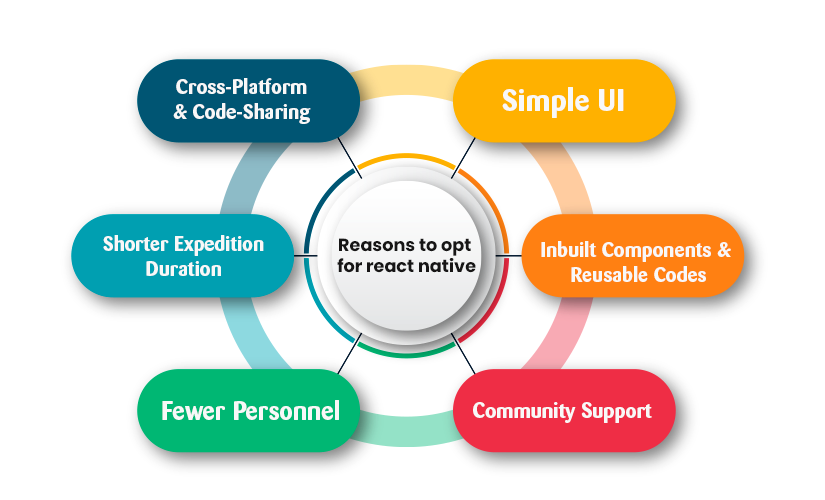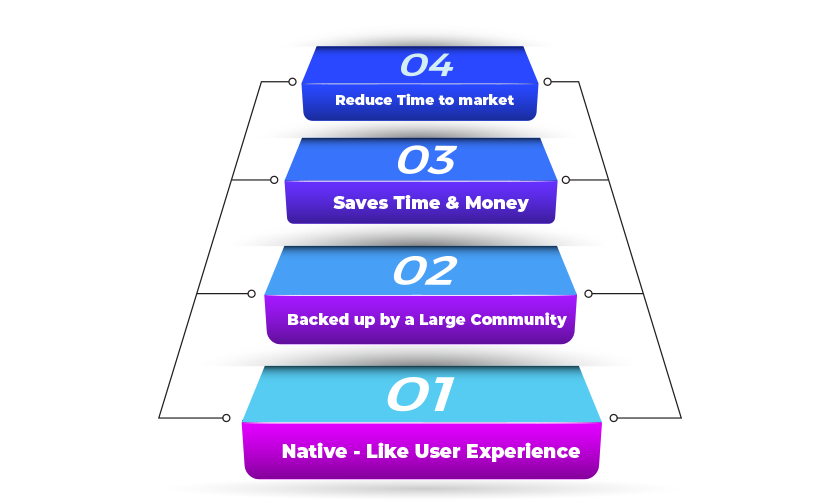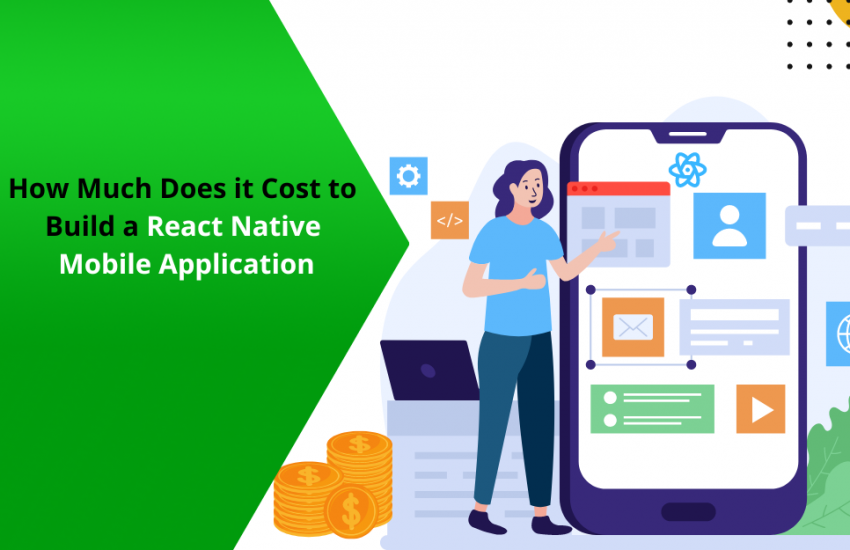Understanding the Elements that Determine the Cost of React Native App!
Let me tell you something very inspiring! By 2023, mobile apps are expected to bring in more than 935 billion dollars of revenue.
It makes sense that 2022 would see a rush to build mobile applications utilizing React Native. React native app is the most popular app framework in the world. Its flexibility and cross-platform mobile app development feature delight everyone. One of the most common issues among e-commerce sellers considering investing in mobile apps is the app development cost.
Earlier, if you wanted to create an app for Android and iOS, you had two options. Either had to think of two completely different native apps or use an HTML5-based framework to create a hybrid app. The drawbacks were that they had severe cost and usability problems.
Mobile apps created with React Native (RN) are fantastic because they are reasonably priced and give you a dependable cross-platform app developing choice. Did we mention that mobile apps created with React Native can resolve severe financial issues? True! So, how much will a React Native app cost in 2022? There isn’t a straightforward response to this query. We know that no one method works for all mobile app development projects, and this also applies to the cost of React Native.
In this blog, we’ll gain insight into a few topics and examine the capabilities and advantages of the app, the reasons why specific businesses use this framework, and several other elements that significantly impact how much it costs to construct a React Native app.
Why do Business Entrepreneurs Choose to Create React Native Apps?

Open-source and cross-platform characteristics are the only reason most business owners and developers prefer to build react native apps. With Facebook’s assistance, it is also used to develop apps compatible with the Android, iOS, Android T.V., macOS, Web, Windows, and tvOS platforms. Additional causes include:
- Cross-Platform & Code-Sharing.
- Shorter Expedition Duration.
- Fewer Personnel.
- Simple UI.
- Inbuilt Components and Reusable Codes.
- Community Support.
Popular Apps Developed with the React Native Solution:
From well-known Fortune 500 companies to trendy emerging startups, thousands of apps use React Native. Check out the apps below to get an idea of what React Native is capable of
Facebook: RN was adopted, and as a result, performance significantly improved with respect to timing. Launching the events dashboard now takes half as long.
Walmart: Utilizing fewer resources and spending fewer time results in improved app performance on the iOS and Android platforms. The outcomes demonstrated barely any performance difference between both these apps. 96% of the codebase was cross-platform, and the organization used developer expertise and experience.
Discord: React Native has made iOS and Android’s code 98 percent standard. The iOS development cycle was greatly accelerated by its effectiveness.
Instagram: Depending on the product, between 85% and 99% of the code was distributed between iOS and Android apps. The team could produce the app faster in this manner than if they had utilized a native solution.
Uber Eats: It received the development tools from React Native to create a user interface and an enjoyable user experience. The app’s interface also benefits from the addition of sound and push alerts.
Bloomberg: The development team finished the iOS and Android versions of the app in just a few months, or about half the time it would have taken without React Native. Before React Native, the teams would have worked on the iOS and Android versions separately, writing much of the code themselves, which would have caused delays and duplication.
React Native also has the benefit of automating code updates, which speeds up the introduction of new product enhancements. Your app reloads immediately and needs to be recompiled.
Do You Plan to Use React Native for Your Next App?
The significant cost savings and faster app development are the reasons for using React Native technology. It excels at building a single mobile application for two different platforms without a complicated user experience.
React Native is a suitable solution for modeling and presenting an idea to the market for business validation because it facilitates rapid application development. Furthermore, this framework enables the quick delivery of new features to suitable systems.
How Can the React Native Framework Cut Costs in Mobile App Development?
Although React Native has existed since 2015, businesses still had to allot a significant expense for creating iOS and Android apps.
Facebook released its new tool to lower the cost of development projects. Facebook created and integrated React Native App with the J.S. library, the foundation for creating an app user interface. Whether a developer works with web or React Native, both may efficiently utilize the enormous library, change how an app feels and looks, and provide a native user experience.
React Native is a JavaScript framework that enables programmers to build genuine Native embedded programs for Android and iOS. React Native platform has several qualities that make it appropriate for all project types, including:
- Making Use Of J.S. As A Programming Language: JavaScript, the amply used, fastest-growing, and preferred programming language among modern developers, is the language app developers utilize with React Native. In addition, 90% of app developers are familiar with this language. Therefore, they are spared the learning curve.
- Simple Implementation of Updates:React Native developers can update the react native app without needing to download them, saving time.
- Reusability of Code Plus Cross-Platform: The two separate native app development costs can be cut in half when using React Native platform. Hire a specialized software development company experienced in maximizing the feature’s advantages and creating several apps from a single codebase.
- Quick Reload: Because they can make quick changes to the code that takes effect right away without downloading the file, it helps React Native developers save much time on development projects.

React Native App Development Cost Influencing Factors:
An app could be highly, moderately complex, or most minor complex. Different aspects influence the complexities of the app, such as:
Complications of an App:
1.Deployment of an Architecture Model: You may want to build a custom mobile application architecture or prefer a backend for the BaaS model. Either way, it enables you to have a ready-to-use backend architecture. With customization, the complexity of the app increases.
2. Creating an Admin Panel: Depending on the number of features you prefer under the control admin panel, the app’s complexity increases. The component involves viewing stats, tracking all app activities, and updating the content without help from the development team.
3. Third-party App Integrations: If you want to create a user-friendly application, include features like third-party login and simple payments. However, these linkages make the app more complicated.
4. In-app Purchase: You might be tempted to integrate in-app purchases in your React Native app if you want a quick return on your investment (ROI). It is intricate despite being attractive.
Classifications:
Depending on the kind of app you’re designing, the complexity of your React Native mobile app will vary. For instance, solo functions for a timer or calculator are more straightforward than those for a mobile commerce app.
Verification:
In contrast to apps that do not require users to sign-up or register, creating a React Native app that requires user verification and login, or user authentication, requires you to go through tangled steps.
Hardware:
App complexity increases if it is hardware dependent. For example, while developing an IoT app with React Native, you must spend more than creating any other native application.
App Maintenance:
The program must be maintained, which requires frequent upgrades, design alterations, bug fixes, etc. Even after the software is completed and released, expenses continue. React Native mobile app development costs up to 20% of the app maintenance yearly.
Team Size:
The price of creating a React Native mobile app will vary depending on how many people are on the development team. To cut the app development costs, you have two options: either work with a professional development business in partnership, or utilize freelancers, but be aware of the job’s uncertain quality.
Location:
React Native app development costs vary depending on where you are. It differs from one country to another, as well as from one state to another, and is affected by many more elements. The agency’s location should always be considered because it significantly affects costs.
Conclusion
React Native app development is a good option if you want to build a mobile app but are currently working within a tight budget. React Native guarantees everything that could cut down on the overall time and expense of app development, from rapid app development to smooth maintenance and simple migration from any chosen platform. Building React Native apps is the most cost-efficient option compared to other frameworks in the market.
Feel free to contact us if you have any additional inquiries regarding React Native app development prices or if you want to hire qualified React Native developers to assist you in building a productive app for your company.


